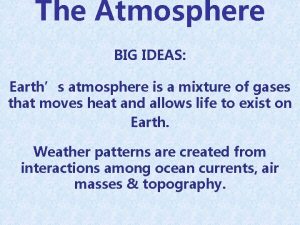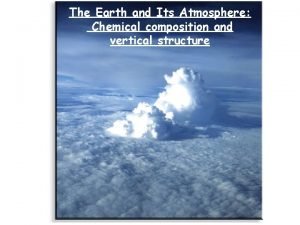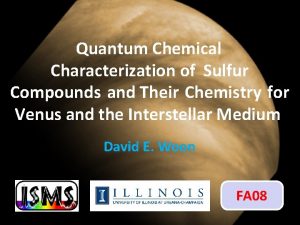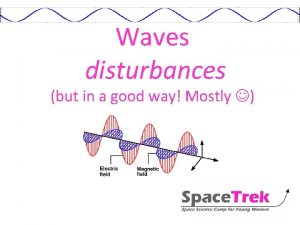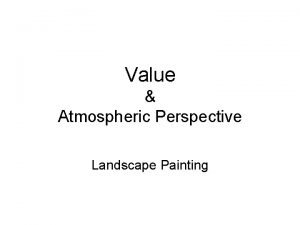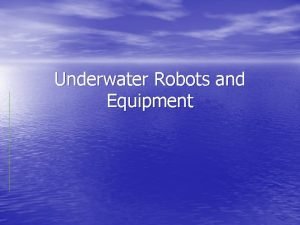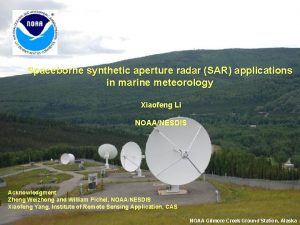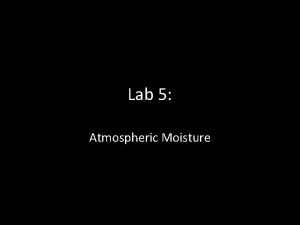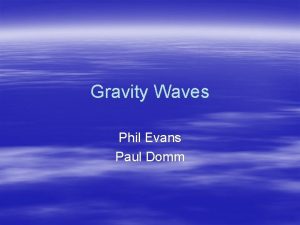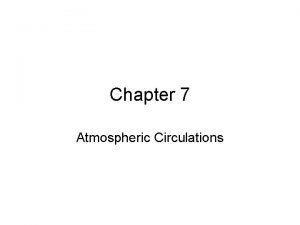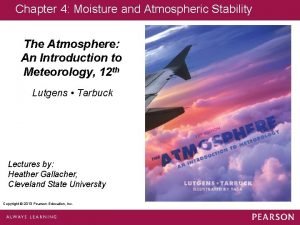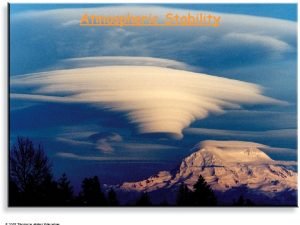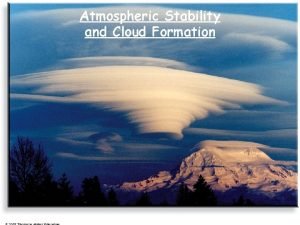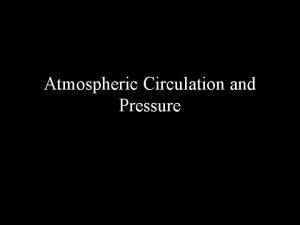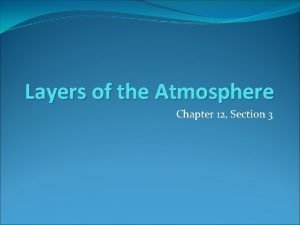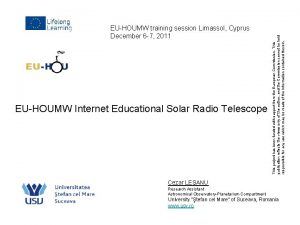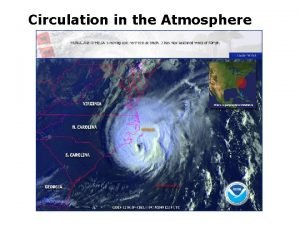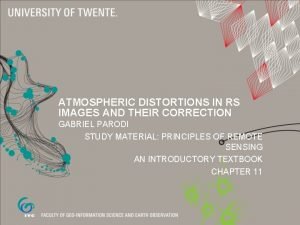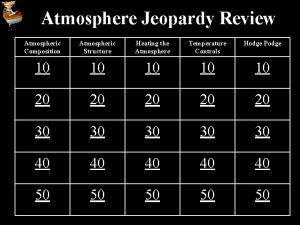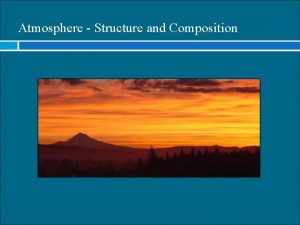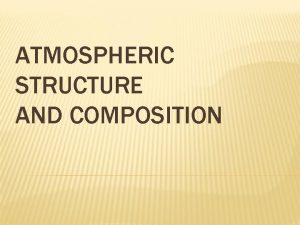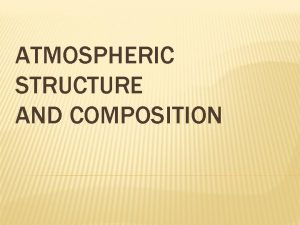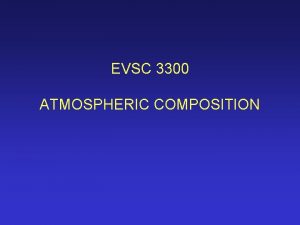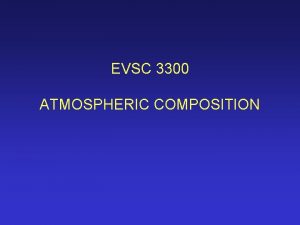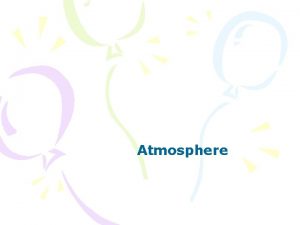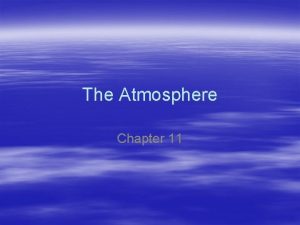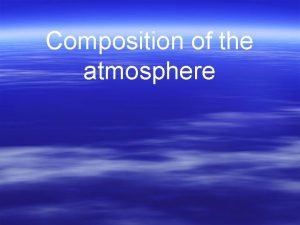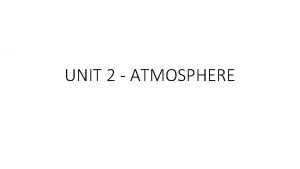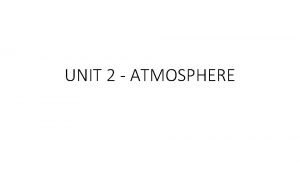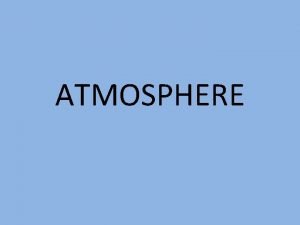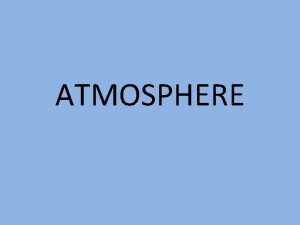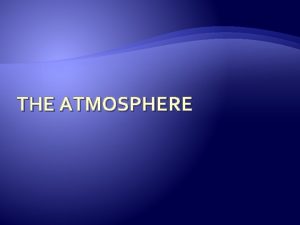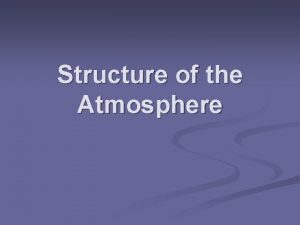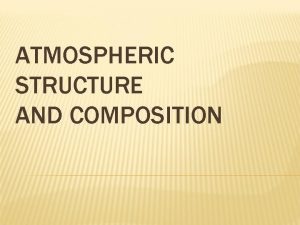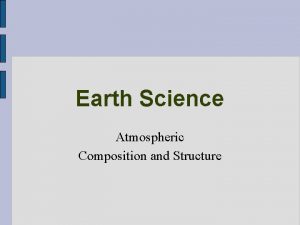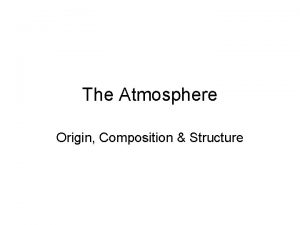Structure of the Atmosphere Atmospheric Composition The atmosphere




















- Slides: 20

Structure of the Atmosphere

Atmospheric Composition • The atmosphere mostly consists of nitrogen (78%), oxygen (21%), and argon. 99% composed of Nitrogen and Oxygen Remaining 1% made up of small amounts of other gases

Atmospheric Thermodynamics Why does the temperature change from one layer to the next?

Troposphere • Closest to Earth • Altitude 0 -10 km • Contains most of the mass of the atmosphere • Weather occurs here, pollution collects • Upper limit called tropopause • Tropopause is where gradual decrease in temperature stops

Stratosphere -Above troposphere -Altitude 10 -50 km -Contains mostly ozone -Ozone absorbs more UV radiation, so this layer is heated -Upper limit called stratopause -Stratopause is where gradual increase in temperature stops

Mesosphere • Above stratosphere • Altitude 50 -80 km • No concentrated ozone here, so temperature drops again • Upper limit called mesopause • Mesopause is where gradual decrease in temperature stops

Thermosphere • Above mesosphere • Altitude 80 km and above until outermost boundary of atmosphere • Contains a small part of the atmosphere’s mass • Little air that is in this layer increases in temperature again to greater than 1000 C

The Ionosphere • The thermosphere can be identified in two parts- the ionosphere and the exosphere. • Ionosphere: 80 km 640 (about 400 miles = 640 km). • It contains many ions and free electrons (plasma). • Auroras occur in the ionosphere.

Auroras A beautiful display of light in the sky that come from interactions between particles from the sun's atmosphere and gases in the ionosphere.

Exosphere • Outermost layer of Earth’s atmosphere • Light gases like helium and hydrogen found here • Above exosphere is outer space • No clear boundary between atmosphere and space

Atmosphere Energy • The Sun is the source for all energy in the atmosphere. • Three ways the energy transfer occurs: • Radiation • Conduction • Convection • Flash Animation

Radiation • Radiation is the transfer of energy through space by visible light, UV radiation, and other forms of electromagnetic waves

Conduction • Conduction is the transfer of heat energy that occurs when particles collide • Through conduction, Earth’s surface transfers energy to nearby air particles in troposphere. • Conduction only affects small layer of atmosphere.

Convection • Convection is the transfer of heat energy by the flow of a heated substance • Pockets of air near Earth’s surface are heated, become less dense and rise • As warm air rises, it expands and starts to cool. As it cools, its density increases and the cooler air sinks. As it sinks, it warms again and process starts over.

Temperature and Heat • Temperature-measurement of energy of a substance; interprets atmospheric processes. • Heat-transfer of energy from two objects of different temperatures; fuels atmospheric processes.

Pressure and Density • Air pressure increases towards Earth’s surface because of the greater mass of the atmosphere above you. • Atmospheric pressure decreases with height because there are fewer gas particles above you. • Density is proportional to amount of particles.

Atmospheric Relationships

Atmospheric Pressure & Density Dynamics What happens to pressure and density as you go higher in the atmosphere? Why do changes in pressure & density occur?

Temperature Inversion • A condition in which cold air underlies warmer air that is at a higher altitude. • This occurs when the air near the ground rapidly loses it heat on a clear night. In this situation, the ground becomes cooled quickly while the air above it retains the heat the ground was holding during the day.

Temperature Inversion
 Atmosphere ideas
Atmosphere ideas Earth's atmosphere composition
Earth's atmosphere composition Hsocl
Hsocl Atmospheric opacity
Atmospheric opacity Atmospheric perspective landscape
Atmospheric perspective landscape Atmospheric suits
Atmospheric suits Atmospheric gravity waves
Atmospheric gravity waves Penn state meteorologists
Penn state meteorologists Lab 5 atmospheric moisture
Lab 5 atmospheric moisture Air pressure at different altitudes
Air pressure at different altitudes Forceparcel
Forceparcel Single cell model of atmospheric circulation
Single cell model of atmospheric circulation Atmospheric stability
Atmospheric stability Define unstable equilibrium
Define unstable equilibrium Conditionally unstable atmosphere
Conditionally unstable atmosphere Circulates air between 60-90 latitudes
Circulates air between 60-90 latitudes Atmospheric heaven
Atmospheric heaven Section 1 atmospheric basics continued answers
Section 1 atmospheric basics continued answers Atmospheric opacity
Atmospheric opacity Atmospheric circulation
Atmospheric circulation Atmospheric distortion correction
Atmospheric distortion correction
